
Characiformes is an order of ray-finned fish, comprising the characins and their allies. Grouped in 18 recognized families, more than 2000 different species are described, including the well-known piranha and tetras.

Characidae, the characids or characins is a family of freshwater subtropical and tropical fish, belonging to the order Characiformes. The name "characins" is the historical one, but scientists today tend to prefer "characids" to reflect their status as a by and large monophyletic group at family rank. To arrive there, this family has undergone much systematic and taxonomic change. Among those fishes that remain in the Characidae for the time being are the tetras, comprising the very similar genera Hemigrammus and Hyphessobrycon, as well as a few related forms such as the cave and neon tetras. Fish of this family are important as food and also include popular aquarium fish species.
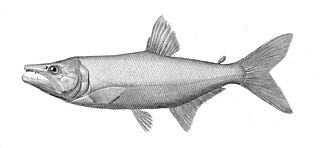
Acestrorhynchus is a genus of 14 species of characiform fish found only in fresh water in South America, the sole genus in the family Acestrorhynchidae. Their greatest diversity is in the Orinoco and Amazon basins.
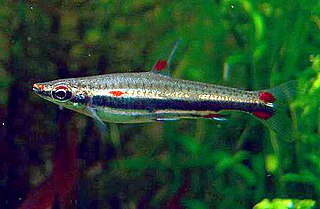
Nannostomus,, is a genus of fish belonging to the characin family Lebiasinidae. All of the species in this genus are known as pencil fish or pencilfish, a popular name that was first only applied to two species in the 1920s, Nannostomus unifasciatus and Nannostomus eques, but by the late 1950s would come to be applied to all members of the genus. Several of the species have become popular aquarium fish due to their attractive coloration, unique shape, and interesting demeanor.

Franz Steindachner was an Austrian zoologist, ichthyologist, and herpetologist. He published over 200 papers on fishes and over 50 papers on reptiles and amphibians Steindachner described hundreds of new species of fish and dozens of new amphibians and reptiles. At least seven species of reptile have been named after him.
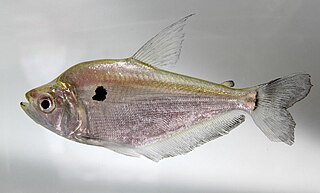
Roeboides is a genus of characins from Central and South America. These fish, among other characteristics, are small, are typically translucent, and have a rhomboid shape.
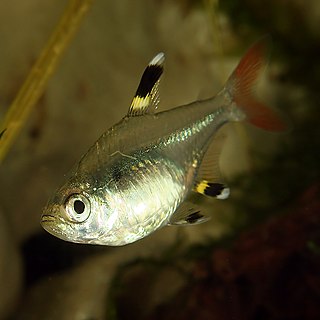
Pristella maxillaris is a species of characin in the genus Pristella, and is commonly known as the X-ray fish or X-ray tetra because of its translucent body. It is a widely distributed and adaptable fish, found in the Amazon and Orinoco basins, as well as coastal rivers in the Guianas in both acidic and alkaline waters. Unlike most other characins, it is tolerant of slightly brackish water. It is small and lives in large groups, and males can be distinguished from females by being smaller and thinner than the females. Like most other tetras, it feeds primarily on small insects and planktonic animals.

Cheirodon is a genus of characins occurring in South America. Of the 10 currently described species; one, C. jaguaribensis, is placed here as a convenience, as its actual position in Characidae is unknown.

Poptella is a genus of fish in the characin family found in tropical South America, with four currently described species:
Axelrodia is a genus of small characin from the Amazon Basin and Meta River in South America, with three currently described species:
Heterocheirodon is a genus of characins from South America, with two described species:
Macropsobrycon is a genus of characins from eastern South America. The currently described species in this genus are:
Parapristella is a genus of characins found in northern South America. Currently, two species are described in this genus:

Prionobrama is a genus of characins found in tropical South America, with two currently described species:
Pseudocheirodon is a genus of characins found in southern Central America. There are currently two described species in this genus.
Stethaprion is a genus of characins fish from tropical South America. The currently described species in this genus are:

Boulengerella is a genus of pike-characins from tropical South America, found in the Amazon Basin, Orinoco, and rivers of the Guiana Shield. The currently described species are:
Gilbertolus is a genus of dogtooth characins from northwestern South America, restricted to the Atrato, Magdalena and Maracaibo basins.

Hydrolycus is a genus of large dogtooth characins from tropical South America, where found in the Amazon and Orinoco basins, as well as rivers of the Guianas. The genus includes the largest dogtooth characins, reaching up to 1.17 m (3.8 ft) in length. They have long, pointed teeth used for spearing their prey, generally smaller fish. In a study of the stomachs of 45 individuals, most were empty, but among the remaining the prey fish were 15–50% of the length Hydrolycus itself.
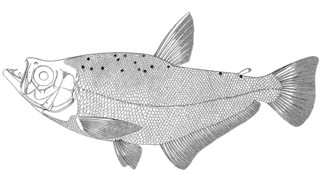
Roestes is a genus of dogtooth characins from tropical South America, where found in the Amazon Basin and various rivers in the Guianas. There are three described species in this genus.













